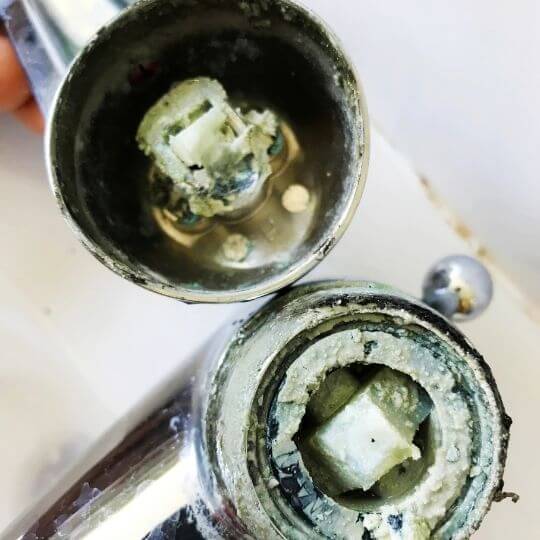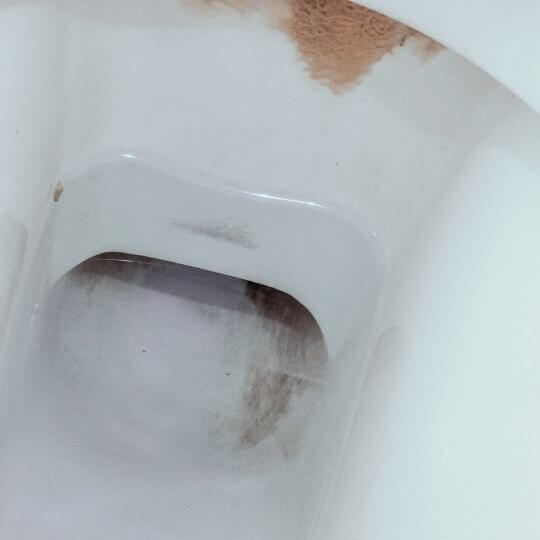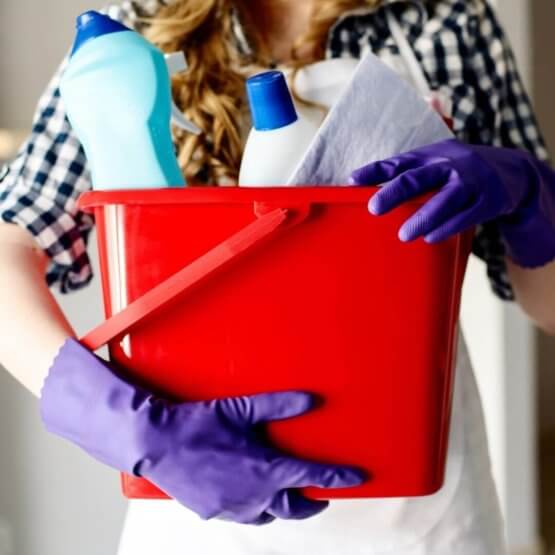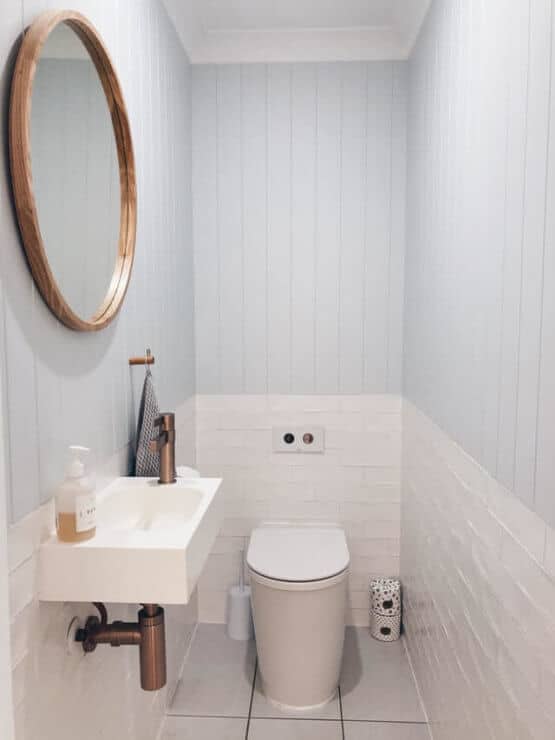Wherever there is water in the bathroom, limescale is bound to occur, especially in the toilet bowl. So no matter how clean you keep your toilet, limescale buildup is something that happens even to the most hygienic. Nonetheless, the sight of limescale is far from pretty. Therefore a frequently asked question from homemakers is: “how to remove limescale from toilet below waterline?” Luckily, getting rid of limescale or minimizing its appearance is not impossible!
What Is Limescale?

Before telling you how to remove limescale from toilet below waterline, you need to know what limescale is.
The hard, chalky deposit that appears at the bottom of your toilet is known as limescale. It consists mainly of calcium carbonate [1] and comes forth in kettles, hot water boilers, pipework, etc. It is prevalent in elements where hot or standing water is present. Limescale can also be found where hard water has evaporated, like on old pipes’ inner surfaces, for example. In other words, limescale is the result of hard water buildup.
The color of limescale can vary, from off-white to a range of greys, pinks to reddish browns. The color of the limescale deposit will mainly depend on the presence of other minerals present. For instance, if the water contains iron, the limescale will most likely be a reddish-brown color.
While limescale is a sight for sore eyes, its appearance should be the least of your worries. Additionally, limescale can also cause severe damage to components like water heaters and plumbing. Therefore it is essential to get rid of it or keep the limescale buildup under control as much as possible. In most cases, descaling agents are most commonly used to get rid of limescale in the toilet.
Why Is Limescale Present In Some Toilets?

As mentioned before, limescale is mainly the result of hard water buildup. So if you live in an area where hard water is present, the chances are good that limescale will build up in your toilet.
However, it may so happen that you have toilet-limescale, but your neighbor with the same hard water, does not. The reason for this is not because your neighbor cleans his toilet more often. It is more likely that his toilet instead is protected against limescale through an enamel layer.
Most toilets have an enamel layer that prevents limescale from building up. [2] However, if this enamel layer has been damaged, the limescale will eventually start making an appearance.
Therefore, one should be cautious about the types of cleaning agents one uses in the toilet. Bleach, for example, can damage the enamel layer and strip it from the toilet. The same counts for other abrasive cleaners, many of them are harmful to the toilet’s enamel layer.
You will notice that most often limescale in your toilet forms under the waterline. Therefore if you are looking for limescale removers, you need to ensure that the products can be used to clean limescale below the waterline.
How To Remove Limescale From Toilet Below Waterline

In most cases removing limescale will demand a fair amount of elbow grease. One can either use a store-bought chemical such as CLR to remove limescale or a natural method. Keep in mind that the natural process might need extra scrubbing, but it is less harmful to your toilet.
You must be aware that it will be much more challenging to remove limescale without removing the water. The only time water is needed in the bowl to clean limescale is when you are using toilet limescale remover tablets. These products usually require water to dissolve.
If you are pouring a descaling solution into a toilet bowl full of water, it will dilute the product.
Therefore the best strategy on how to remove limescale from toilet below waterline is to remove the water before cleaning.
How To Drain Your Toilet Bowl

The first thing you will have to do is to turn off the water supply. This will prevent the bowl from filling with water again. Next, you will flush the toilet so that the water goes down the drain.
There will still be some water left in the toilet bowl after the flush. Even this tiny amount of water is not acceptable as it will hinder the cleaning process.
To get rid of the water completely, you can try and scoop out the water with a small cup. The rest of the water can be soaked up with a sponge or a towel. After this, your toilet bowl should be dry and ready for action.
How To Get Rid Of Bad Limescale In Toilet With A Descaling Liquid?
Once you have drained your toilet, you can simply pour the descaling liquid of your choice into the toilet. Most of these products will have instructions on how long you should leave the solution to sit.
Once you have left it for an extended period, you can start scrubbing. If you are satisfied with the results, you can rinse the bowl and open the waterline again. If the limescale is still present, you can either repeat the method or try another one.
How To Clean Thick Limescale In Toilet Naturally
Certain natural products like white vinegar are great for cleaning the toilet. Not only is white vinegar a powerful cleaner when it comes to toilets, but they are also excellent for a variety of household cleaning tasks. However, since it is a natural product, it is not as strong as store-bought descalers. [4]
If you decide to give vinegar a go, you will also have to clear the water from your toilet bowl first. The next step is to pour 1 liter of undiluted white vinegar inside the toilet bowl. To get under the toilet rim, you can soak paper towels in vinegar and place them under the rim. The aim is to have the vinegar in direct contact with the limescale.
Next, you need to leave it to work its magic for about 4 hours. The secret is to leave it to soak in the toilet for as long as possible. After it has sat for a while, start scrubbing with a toilet brush. Flush the toilet to rinse the vinegar and dirty water and if needed, repeat the process.
Vinegar is best to use if you want to prevent the buildup of limescale. It is also a good option if you have a less severe case of limescale. Nevertheless, it is worth the shot if you don’t want to resort to chemical cleaners.
Other Things You Can Try To Get Rid Of Toilet Limescale
Because limescale can be very tough to get rid of, there is no magic solution to the problem. If you’re lucky, you might get rid of it with the first product you use. If not, it might take a couple of trials and errors with different products before the stain is completely gone. The reason for this is because the limescale varies in mineral components. Different products will react differently to different minerals, and therefore not all will work the same for every stain.
Additionally, you can try limescale tablets. These tablets are very effective in most cases, and the best part is that you don’t have to drain the toilet bowl.
Another product you can use is WD40. Limescale toilet or not, wd40 makes an excellent cleaning product around the house.
Since it is not easy cleaning your toilet bowl from the waterline to the back of the U-bend. Some toilet brushes can’t even reach these spots, which is why stains are more common here. Toilet siphon jets are especially hard to clean. Therefore you might want to invest in a flexible toilet brush to make the task easier for you. One with a flexible D-shape head is an excellent option to get to those hard-to-reach places.
A cleaning stone or a sanding sponge might also come in handy if you want to remove the limescale physically. With these products, you can chip away on the limescale without getting cleaning products involved.
Conclusion
The best methods on how to remove limescale from toilet below waterline will depend on how much limescale is present. If your toilet bowl has a thin layer of limescale, vinegar and a good scrub might work well enough. On the other hand, tough limescale stains might ask for stronger products and multiple cleans. Nonetheless, removing the limescale is not impossible! Just remember that once you get rid of it, it is best to prevent another buildup through regular maintenance.

Michael Davis is a heating & plumbing expert who currently works as independent contractor in SC. He also writes for Plumbertip.
For almost 10 years he worked on various plumbing tasks across South Carolina.


